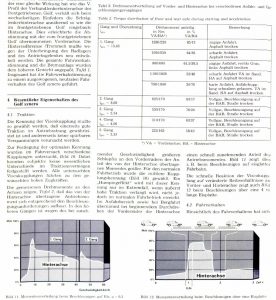As we mentioned in the last section of this blog article already, a working viscous coupling will always relieve the gear box from a certain amount of load – even on dry pavement.
Unfortunately, we were not able to quantify this percentage. Now, for the first time, we have reliable measurements for quantifications, which is quite amazing.
Searching for data about the viscous coupling of the Golf 2 Syncro we came across an article in the ATZ Journal (Automobil Technische Zeitschrift) of 1986. VW performed measurements of the torque distribution between front- and rear axles in different driving situations:
The prevailing opinion regarding the Viscous-coupling only activates on loose surfaces such as: ice, snow & sand and runs useless on tarmac. In this notion, however, the always present tire slip is forgotten. In other words, in order to transmit driving forces, a tire must always slip to a certain degree – even if it is invisible to the naked eye. In a brochure Continental speaks about tire wear slip values in the range of 2 – 20 % at rapid acceleration on dry roads.

VW measured for the front-wheel driven Golf 2 Syncro at full throttle acceleration in 5th gear a torque distribution of 58/42 on dry roads (!). At high speeds, almost half of the drive power is transmitted via the viscous coupling and relieves the gear box. One can see clearly from the table how the torque-distribution steadily increases on the rear axle with increasing speed.
Due to the dynamic weight transfer, the primary driven rear axle of the T3 Syncro has certainly an advantage during acceleration. Therefore lower slip values on the rear axle can be expected for the T3 Syncro in comparison with the front-wheel driven Golf. But when it comes to air resistance at high speeds, the Golf obviously has it’s leg up on the T3
Permanent four-wheel drive relieves the gear box of the T3 Syncro, especially on dry tarmac when the driver puts the pedal to the metal.
